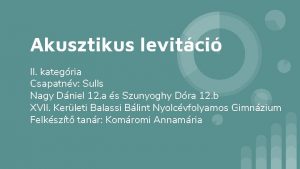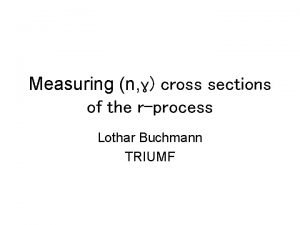Acoustic Upsidedown Levitator With A Solid Sample Lothar

- Slides: 1

Acoustic Upside-down Levitator With A Solid Sample Lothar Holitzner 1, Ernst Günter Lierke 2 1. Paul Scherrer Institut, Laboratory for Scientific Developments and Novel Materials, Villigen, Switzerland; 2. tec 5 AG, Oberursel, Germany. Introduction: Acoustic levitators are used to levitate small samples (ca. 0. 01 - 6 mm) at a stable position in a gaseous or liquid environment. Acoustic levitators were first developed und used for experiments in space (1970 s, by NASA / ESA), the application later became terrestrial (1990 s). Meanwhile acoustic levitators are widespread. With the help of COMSOL Multiphysics® , we present a practical model, to show basic properties and interactions and some additional phenomena und aspects in a stepwise approach to the realistic world of acoustic levitators. In this acoustic levitator model the millimetre-sized spherical sample is located (in air environment) below the piezoelectric transducer (mechanical coupled resonator), which radiates the inaudible sound of 22 k. Hz downwards against the reflector. The transducer is based on a sophisticated 20 k. Hz model, designed by E. -G. Lierke. That version was also used at the Battelle Institute (Frankfurt/Main, Germany) [1]. The current available model contributes to understand details of acoustic levitation and helps to improve acoustic levitators for future applications. Study 1: Piezo preload (Stationary, prestressed) In the 1 st development step of the FEM model, only the transducer was set up and the Structural Mechanics Module was used for a stationary study. In this transducer step, the piezo rings of the assembling transducer are axially preloaded by the central clamping screw region with resulting compressive stress (Bolt Pre-Tension). With open piezo electrode ports, the bolt under resulting piezo voltage indicates pre-tension the mechanical preload in practice (Piezoelectric Effect). resulting piezo voltage (Floating Potential) Figure 1. Piezo voltage and axial stress after prestressing the central bolt. Study 6: Sample position balance (Frequency Domain, prestressed) The mesh of the gas domain, which locally surrounds the solid sample, is based on a Moving Mesh and enables the sample domain to change its position. The 1 st study step (Stationary) calculates the final vertical sample position with a simple force balance equation, defined in Global ODEs and DAEs (ge) and moves the sample by a Prescribed Displacement. The mesh in the sample proximity deforms accordingly. Then, the 2 nd study step (Frequency Domain Perturbation) recalculates the pressure acoustics field in the new geometric situation. This confirms the force equilibrium between sample weight and vertical acoustic radiation forces on the sample surface. Figure 11. Stable levitated sample in force equilibrium at vertical balance position below the 3 rd pressure node The levitation force progression can be investigated with a Parametric Sweep of the vertical sample position over the pressure node region. This force progression is used as an input to study 6. pressure node Study 2: Transducer geometry (Eigenfrequency, prestr. ) In the 2 nd development step, an eigenfrequency study inspects the undamped, axial natural oscillation of the prestressed piezoelectric transducer. By adjusting the transducer geometry, the resonance frequency was tuned to 22 k. Hz and the velocity node placed into the level of the fixing flange. This Eigenfrequency study also helps, to exclude undesired tilt and pendulum oscillations of the transducer. position (velocity antinode) driver fixing flange (velocity node) Figure 10. Vertical force Faco. z from acoustic radiation pressure at different vertical sample positions. Faco. z = Faco. bottom + Faco. top sonotrode Study 4: Transducer motion (Time Dependent) Figure 3. Undesired oscillation at 19963 Hz (deformation scale (velocity antinode) factor = 130) Figure 2. Total displacement (amplitude) at transducer Eigenfrequency 22002 Hz (deformation scale factor = 500) This study explores the transducer oscillation at the resonance frequency (22 k. Hz) in timewise resolved motion sequence. Study 3: Frequency scan (Frequency Domain, prestressed) A frequency domain study (Harmonic Perturbation) vibrates the prestressed piezoelectric transducer to harmonic oscillations (with use of the AC/DC Module). The frequency scan over the resonance range also shows the internal mechanical (Rayleigh) Damping in the transducer material with the shape of the amplitude resonance curve (reasonable damping values taken Figure 9. Snapshot of the from e. g. annealed high-grade titanium alloy). Figure 8. Transducer displacement field, Z-component, axial stress in the transducer. The Acoustics Module was used, to calculate the Acoustic-Solid Interaction between resp. piezo voltage during swing up. (deform. scale factor = 3000) transducer, acoustic levitation field, reflector and solid sample. The oscillating transducer radiates its maximum power into the gas domain, when the distance between sonotrode face and (spherical curved) reflector is tuned to resonance, namely at max. acoustic impedance. Fig. 6 shows an optimized intense sound field with 5 stationary pressure nodes in the acoustic standing rd pressure node. Fig. 7 indicates the frequency-dependent power wave. A sample sphere Ø 4 mm is placed in the 3 AC voltage stainless steel (1. 4435) transfer on the way from the piezo electrodes into the levitation sound field. (Note: Fig. 4 to Fig. 7 with Upiezo = 7 Vrms ) (Harmonic Pertubation) Ti 6 Al 4 V (3. 7165) Rayleigh damping with material quality factor Q = 1500 - resulting mass damping parameter α = 45. 936 [1/s] - resulting stiffness damping parameter β = 2. 409 e-9 [s] 3 rd pressure node Figure 4. Displacement amplitude at 22000 Hz sound field sonotrode face [1] L. Holitzner, Verbesserung der Funktions. Charakteristik eines elektrostatisch akustischen Hybridlevitators, FH Wiesbaden, Battelle Institut, Frankfurt/M. , 1992 Figure 5. Displacement amplitude, zcomponent. reflector Figure 6. Sound pressure level in the gas domain beween transducer and reflector Figure 7. Input: Electrical power, calculated from piezo current and voltage. Output: Acoustically radiated power, calculated at the sonotrode face boundaries [2] Alon Grinenko, How to Compute the Acoustic Radiation Force, COMSOL BLOG, January 29, 2015 [3] Mads Herring Jensen, COMSOL Support Case 3000332, 2018

